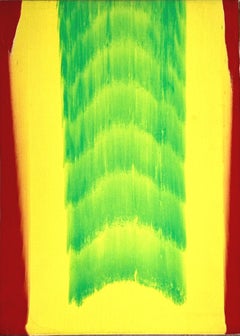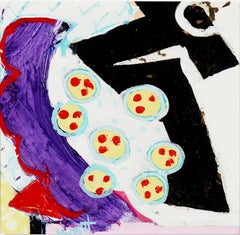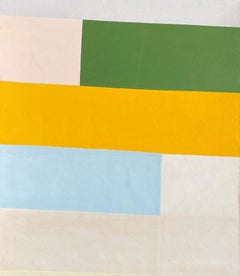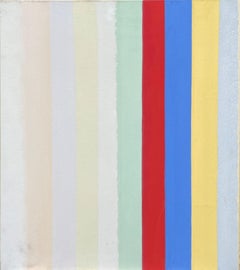Want more images or videos?
Request additional images or videos from the seller
1 of 4
Kikuo Saito"Seven Causeways, " Kikuo Saito, Abstract Expressionism, Lyrical Abstraction1977
1977
About the Item
- Creator:Kikuo Saito (1939, Japanese)
- Creation Year:1977
- Dimensions:Height: 22 in (55.88 cm)Width: 93 in (236.22 cm)
- Medium:
- Movement & Style:
- Period:
- Condition:
- Gallery Location:New York, NY
- Reference Number:1stDibs: LU1841211648962
Kikuo Saito
With ties to the Color Field tradition, Saito’s color landscapes are a richly infused exhibition of dragged and poured paint, often with bold flecks of color, animated calligraphic line, and stenciled lettering. Influenced by his work in theatre, many of his compositions are directly related to the movements and lights found on stage, as is the case with Crocodile Boogie. Japanese born and trained Kikuo Saito (1939–2016) moved to New York in 1966 where he worked as a carpenter while acting as studio assistant to Helen Frankenthaler, Kenneth Noland, and Larry Poons. Saito had long association with La MaMa Experimental Theatre Club in New York creating costumes, set design, and directing. His productions drew inspiration from traditional and avant-garde Japanese theatre. Saito's paintings and are in the permanent collections of the Museum of Modern Art, the Aldrich Contemporary Museums, and numerous private and corporate collections. KinoSaito, a non-profit museum and art space in Verplanck, New York, opened in 2020, in honor of Saito's interdisciplinary practice and spirit.
About the Seller
5.0
Platinum Seller
Premium sellers with a 4.7+ rating and 24-hour response times
Established in 2022
1stDibs seller since 2022
122 sales on 1stDibs
Authenticity Guarantee
In the unlikely event there’s an issue with an item’s authenticity, contact us within 1 year for a full refund. DetailsMoney-Back Guarantee
If your item is not as described, is damaged in transit, or does not arrive, contact us within 7 days for a full refund. Details24-Hour Cancellation
You have a 24-hour grace period in which to reconsider your purchase, with no questions asked.Vetted Professional Sellers
Our world-class sellers must adhere to strict standards for service and quality, maintaining the integrity of our listings.Price-Match Guarantee
If you find that a seller listed the same item for a lower price elsewhere, we’ll match it.Trusted Global Delivery
Our best-in-class carrier network provides specialized shipping options worldwide, including custom delivery.You May Also Like
I'd Slay Another Dragon for You
Located in Fresno, CA
This square edge filled canvas presents a mesmerizing yet relaxing spectrum of perfectly blended pigment. “I'd Slay Another Dragon for You” is from the “Mindfulness Circle” series by artist Ethan Blu...
Category
2010s Abstract Abstract Paintings
Materials
Canvas, Acrylic
"Decompression of Thoughts"
Located in Rio Vista, CA
Fascinating large scale abstract impressionist style acrylic on canvas painting by Cyrstofer/Christopher Shoemaker (Italian/German 20th c). Features a grey, blue, and lavender ground...
Category
20th Century Abstract Abstract Paintings
Materials
Canvas, Acrylic
"The Fourth Facade"
Located in Rio Vista, CA
Large abstract impressionist style figural painting titled "The Fourth Facade" by Cystofer/Christopher Shoemaker (Italian/German 20th c). Shoemaker calls Co...
Category
20th Century Abstract Abstract Paintings
Materials
Canvas, Acrylic
Back and Forth
By Diane Ayott
Located in Gloucester, MA
Diane Ayott’s abstractions on paper, canvas, and panel are luxuriously physical objects resulting from the accrual of layer after layer of paint, color, and pattern, launched by imag...
Category
2010s Abstract Abstract Paintings
Materials
Canvas, Mixed Media, Acrylic
Softly
Located in Gloucester, MA
Patton Blackwell's "Softly" comprises four gallery-wrapped canvases 71 x 31.5 in. each, 71 x 126 in overall. It can be hung on the wall as a painting,...
Category
1990s Abstract Abstract Paintings
Materials
Canvas, Acrylic
Medium Sized, Colorful, Women in Abstract Expressionism Oil Painting w/ Sunset
Located in Fort Worth, TX
Women in Abstract Expressionism: Colorful Sunset Inspired Artwork by Texas artist Winter Rusiloski.
Details:
Winter Rusiloski
Cathedral, 2016
Oil on canvas
48 x 45"
View works.
Wind...
Category
2010s Abstract Expressionist Abstract Paintings
Materials
Canvas, Oil, Acrylic
Abstract B3
Located in San Juan, PR
CARLOS MERCADO
ABSTRACT
Inspired in the work of Franz and Ives Klein
This body of work was produced during the initial months of the lock down due to the pandemic. This tragedy crea...
Category
2010s Abstract Abstract Paintings
Materials
Canvas, Acrylic
Yves Klein Blue M4
Located in San Juan, PR
CARLOS MERCADO
ABSTRACT
Inspired in the work of Franz and Ives Klein
This body of work was produced during the initial months of the lock down due to the pandemic. This tragedy crea...
Category
2010s Abstract Abstract Paintings
Materials
Canvas, Acrylic
Abstract Yves klein Blue 4
Located in San Juan, PR
CARLOS MERCADO
ABSTRACT
Inspired in the work of Franz and Ives Klein
This body of work was produced during the initial months of the lock down due to the pandemic. This tragedy crea...
Category
21st Century and Contemporary Abstract Abstract Paintings
Materials
Canvas, Acrylic
Big bang Abstract 3
Located in San Juan, PR
CARLOS MERCADO
ABSTRACT
Inspired in the work of Franz and Ives Klein
This body of work was produced during the initial months of the lock down due to the pandemic. This tragedy crea...
Category
2010s Abstract Abstract Paintings
Materials
Canvas, Acrylic
More From This Seller
View All"Untitled" Gene Hedge, Abstract Color Field, Yellow Pattern Midcentury Painting
Located in New York, NY
Gene Hedge
Untitled, circa 1970
Acrylic on canvas
29 x 20 3/4 inches
(P097)
Gene Hedge was born (1928) and raised in rural Indiana. After military service, he briefly attended Ball State University in Muncie, Indiana. There he encountered the writing of Laszlo Moholy-Nagy, and the following year (1949) went to study at the Institute of Design in Chicago. He received a B.S. degree in Visual Design from the Institute of Design (1953), and he also took courses at the Art Institute of Chicago and began working in collage.
During this period, the influence of Eugene Dana...
Category
1970s Abstract Abstract Paintings
Materials
Canvas, Acrylic
"Untitled" Knox Martin, Abstract Expressionism, Purple, Yellow, Black
By Knox Martin
Located in New York, NY
Knox Martin (1923 - 2022)
Untitled
Signed to lower edge
Acrylic and gold foil on canvas
9 x 9 inches
Knox Martin (1923-2022) was an esteemed New York School painter. Knox Martin was born in 1923 in Barranquilla, Colombia. He was the son of the aviator, painter, and poet William Knox Martin, the first man to fly over the Andes Mountains.
After serving in World War II, Knox Martin attended the Art Students League of New York on the G.I. Bill from 1946-1950, where he studied with Harry Sternberg, Vaclav Vytlacil, Will Barnet, and Morris Kantor.
In 1954, Knox Martin's friend Franz Kline placed a painting of his in the Stable Gallery Annual. Charles Egan of the renowned Charles Egan Gallery saw Knox Martin's painting at the Stable Gallery and asked Martin to show his work in a one-man show for the tenth anniversary of the Egan Gallery.
Since then, Knox Martin was a celebrated painter, sculptor and muralist. Knox Martin had an extensive exhibition record and his work is in museum, corporate and private collections worldwide. His two best-known murals in NYC are Venus and Woman with Bicycle...
Category
Late 20th Century Abstract Abstract Paintings
Materials
Gold, Foil
"Untitled" Calvert Coggeshall, Abstract Expressionism Hard-edge Stripes
Located in New York, NY
Calvert Coggeshall
Untitled, circa 1975
Oil on canvas
50 x 40 inches
Calvert Coggeshall worked as an abstract painter and interior designer primari...
Category
1970s Abstract Expressionist Abstract Paintings
Materials
Canvas, Acrylic
"Notes XXI" Calvert Coggeshall, Abstract Expressionism Hardedge Vertical Stripes
Located in New York, NY
Calvert Coggeshall
Notes XXI, 1973
Signed, titled, and dated on the reverse
Japanese pigment on canvas
29 x 29 inches
Calvert Coggeshall worked as ...
Category
1970s Abstract Expressionist Abstract Paintings
Materials
Canvas, Acrylic
"Inside Blue" Gene Hedge, Abstract Color Field, Bauhaus Midcentury Painting
Located in New York, NY
Gene Hedge
Inside Blue, 1966
Acrylic on canvas
61 1/4 x 43 3/4 inches
(P124)
Gene Hedge was born (1928) and raised in rural Indiana. After military service, he briefly attended Ball State University in Muncie, Indiana. There he encountered the writing of Laszlo Moholy-Nagy, and the following year (1949) went to study at the Institute of Design in Chicago. He received a B.S. degree in Visual Design from the Institute of Design (1953), and he also took courses at the Art Institute of Chicago and began working in collage.
During this period, the influence of Eugene Dana...
Category
1960s Abstract Abstract Paintings
Materials
Canvas, Acrylic
"Lexington, " Larry Zox, Abstract Expressionism, Minimalism, Brown Modernism
By Larry Zox
Located in New York, NY
Larry Zox
Lexington, 1973
Acrylic on canvas
61 x 49 inches
Provenance:
Andre Emmerich Gallery, New York
Janie C. Lee Gallery, Houston, Texas
Private Collection, Greenwood Village, Colorado
Exhibited:
New York, Andre Emmerich Gallery, Larry Zox: New Paintings, March 10 - 28, 1973.
Houston, Texas, Janie C. Lee Gallery, Larry Zox, February - April, 1974.
A painter who played an essential role in the Color Field discourse of the 1960s and 1970s, Larry Zox is best known for his intensely and brilliantly colored geometric abstractions, which question and violate symmetry. Zox stated in 1965: “Being contrary is the only way I can get at anything.” To Zox, this position was not necessarily arbitrary, but instead meant “responding to something in an examination of it [such as] using a mechanical format with X number of possibilities." What he sought was to “get at the specific character and quality of each painting in and for itself,” as James Monte stated in his introductory essay in the catalogue for Zox’s 1973–74 solo exhibition at the Whitney Museum of American Art. Zox also at times used a freer, more intuitive method, while maintaining coloristic autonomy, which became increasingly important to him in his later career.
Zox began to receive attention in the 1960s, when he was included in several groundbreaking exhibitions of Color Field and Minimalist art, including Shape and Structure (1965), organized by Henry Geldzahler and Frank Stella for Tibor de Nagy, New York, and Systemic Painting (1966), organized by Lawrence Alloway for the Guggenheim Museum. In 1973–74, the Whitney’s solo exhibition of Zox’s work gave recognition to his significance in the art scene of the preceding decade. In the following year, he was represented in the inaugural exhibition of the Hirshhorn Museum, which acquired fourteen of his works.
Zox was born in Des Moines, Iowa. He attended the University of Oklahoma and Drake University, and then studied under George Grosz at the Des Moines Art Center. In 1958, Zox moved to New York, joining the downtown art scene. His studio on 20th Street became a gathering place for artists, jazz musicians, bikers, and boxers. He occasionally sparred with visiting fighters. He later established a studio in East Hampton, a former black smithy used previously by Jackson Pollock.
Zox’s earliest works were collages consisting of pieces of painted paper stapled onto sheets of plywood. He then produced paintings that were illusions of collages, including both torn- and trued-edged forms, to which he added a wide range of strong hues that created ambiguous surfaces. Next, he omitted the collage aspect of his work and applied flat color areas to create more complete statements of pure color and shape. He then replaced these torn and expressive edges with clean and impersonal lines that would define his work for the next decade.
From 1962 to 1965, he produced his Rotation series, at first creating plywood and Plexiglas reliefs, which turned squares into dynamic polygons. He used these shapes in his paintings as well, employing white as a foil between colors to produce negative spaces that suggest that the colored shapes had only been cut out and laid down instead of painted. The New York Times noted in 1964: “The artist is hip, cool, adventurous, not content to stay with the mere exercise of sensibility that one sees in smaller works.”
In 1965, he began the Scissors Jack series, in which he arranged opposing triangular shapes with inverted Vs of bare canvas at their centers that threaten to split their compositions apart. In several works from this series, Zox was inspired by ancient Chinese water vessels...
Category
1970s Abstract Expressionist Abstract Paintings
Materials
Canvas, Acrylic
$44,000 Sale Price
20% Off
Recently Viewed
View AllMore Ways To Browse
Saito Kikuo
Jerome Robbins
Peter Brook
The Artist Mother
Modern Abstract Gouache
Cream And Brown Abstract Art
Drip Art
Modern Painting 40 X 60
Triptych Oil
Geometric Mid Century Paintings
Argentina Artists
El Paso
Large Green Painting
Interactive Art
Acrylic Layered Paintings
Red And Orange Painting
San Miguel De Allende
Contour Art



